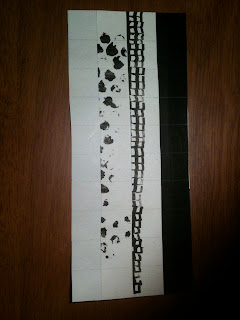Made several designs in paper (the "a" images on the left below).
~~ SECOND STAGE ~~
Then tried them in fabric (the "b" images on the right below.)
7.1 Log cabin paper design with black and printed papers
(with a little help from my cat - the colors of this Module harmonize rather well with her coat ;-)
7.2b designs in fabric (right)
7.3a Log cabin paper designs (left);
7.3b in fabric (right)
7.3b in fabric (right)
7.4 Black, white paper strips and smaller strips, cut and rearranged
7.5 Printed and black, white paper strips
7.6 Strips from 7.5 above rearranged
7.7a Second attempt at printed and black paper strips (left);
7.7b and in fabric (right)
7.7b and in fabric (right)
7.8 Strips from 7.7 above rearranged...
7.9 and rearranged again...
7.10 and again...
7.11a cut, and rearranged a final time
in paper (left);
7.11b in fabric (right)
in paper (left);
7.11b in fabric (right)
7.12 Two strips, cut and sewn together...
7.13 Added white and striped strips to the top strip in 7.12,
cut, arranged and sewn together...
cut, arranged and sewn together...
7.14 Final piece with black and white border
7.15 Just playing
In 7.15 above, after making another section like the top sample in 7.12 above, I cut the pieces at an angle, and then turned alternate pieces over, revealing the seams, before sewing into this construction.
I then took four new pieces of printed, bought patterned and white fabrics. Using the ideas we tried in Chapter 3 (Machine Stitchery), I sewed a giraffe-like pattern onto one of the darker materials, and a starburst zigzag pattern onto a lighter. It's kind of hard to see in the photo below (7.16), but I think it adds a little something to the pieces to make them more interesting.
7.16 Cut, rearranged and sewn once...
7.17 ... and cut once again,
this time at angles,
repositioned and sewn together
Ooh, this is fun! Let's do some more...
7.18a Another Log Cabin pattern
in paper (left);
7.18b and in fabric (right)
In 7.18b above, I used smaller inserts of seminole patterns within the Log Cabin method.
7.19a Another pattern of the
seminole method in paper (left);
7.19b the same pattern in fabric (right)
In 7.19a above, I used photocopied samples of my dyed fabrics (THANK YOU, Sian, for the great suggestion!). Then, when I went to do it in fabric, it helped me a great deal to figure out which sides needed to be sewn together. I read Chapter 8 and decided to play. I happened to have some scraps from earlier pieces above, and put one - a kind of knit fabric - in between when sewing the seam. When I frayed it, it ended up looking like the mane on a zebra when viewed against the wide stripes of the fabric pieces (7.19b). Serendipity! (Also used the back side of a tiger pattern bought fabric which made it more subtle.)
7.20 Close-up of seams of 7.19b above

7.21a Final practice piece in paper (left);
7.21b and in fabric (right)
In 7.21a above, again, I used photocopies of painted and dyed fabrics, making first the long strips in seminole method, cutting, rearranging, re-gluing. Then, in 7.21b, I used the same fabrics and inserted bits of other fabrics, yarn, and even some of the threads I had pulled out of the "zebra" piece above to sew in at the seams.
7.22 The two pieces together
Lessons learned:
- I am not a seamstress. For me, it's rather SEAM STRESS. I really had trouble with the top and bottom samples in 7.2b and 7.3b. Just couldn't get them to end up with straight rows that ended together. I am in awe of the person who produced the samples in the course book.
Sigh.
Oh, well, forge ahead.
And forging ahead, I found that these processes were a lot of fun! (As long as you don't need to sew too straight.)
- Save little pieces of fabric. You never know when they might come in handy. Happily, this follows the rule of conserving resources and recycling.
- Don't cut the fabric too small. If you do, you either have to sew very teeny tiny seams which then fall apart, or the piece gets lost between larger pieces.
- The mantra is "It's okay to play. It's okay to play..."
- * - * - * - * - * - * - * - * -
Total hours Chapter 7: 17.5 (but had a lot of fun!)

















































